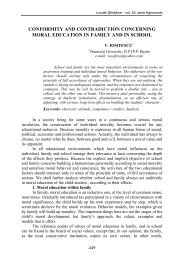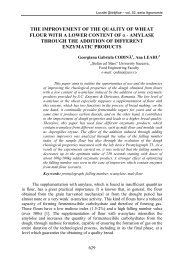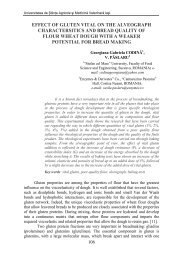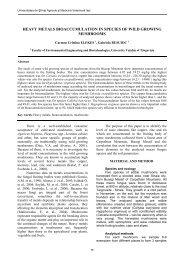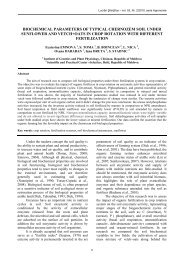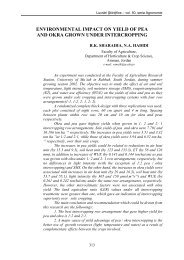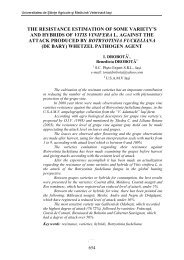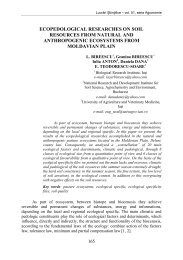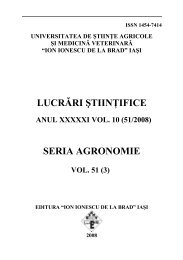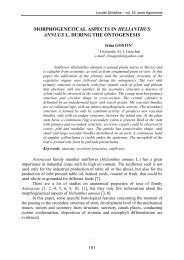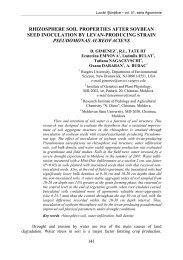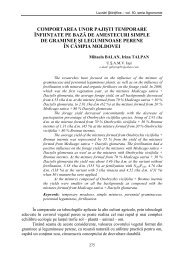introduction to ecosemiotics - LucrÄri ÅtiinÅ£ifice. Seria Agronomie
introduction to ecosemiotics - LucrÄri ÅtiinÅ£ifice. Seria Agronomie
introduction to ecosemiotics - LucrÄri ÅtiinÅ£ifice. Seria Agronomie
You also want an ePaper? Increase the reach of your titles
YUMPU automatically turns print PDFs into web optimized ePapers that Google loves.
Lucrări Ştiinţifice – vol. 51, seria <strong>Agronomie</strong><br />
In the present paper the author attempts <strong>to</strong> demarcate the specifics of<br />
<strong>ecosemiotics</strong>, or semiotic ecology <strong>to</strong> describe and <strong>to</strong> classify some of its main<br />
problems, and <strong>to</strong> introduce several concepts using its specific perspective.<br />
MATERIAL AND METHOD<br />
Not all theories of semiotics are able or willing <strong>to</strong> recognize the semiotic aspects<br />
in organism-environment interactions. For example, F. De Saussure’s (1857-1913)<br />
anthroposemiotics is a semiotics without any ecosemiotic perspective. According <strong>to</strong><br />
Saussure, „nothing” in the cognitive environment of humans is ”distinct before the<br />
appearance of language” (1916:111-12), and even human thought, without the shaping<br />
form of language, is an „indistinct mass”, and „a vague uncharted nebula”, in which<br />
nothing is defined by necessity. Such a linguocentric program of semiosis is bound <strong>to</strong><br />
impede any process of semiosis interaction of the organism and its environment.<br />
A theoretical semiotics of far-reaching ecological implications, by contrast, is the<br />
one of Charles S. Peirce (1839-1914). His interpretation of the interactions between<br />
organisms and their environment seems often <strong>to</strong> be a pansemiotic one. As it results<br />
from his Collected Papers (1931-1958), Peirce distinguishes among the relations<br />
between the objects and the organisms in the environment of humans, between those<br />
which are only dyadic and those which are of a triadic nature, specifying that only<br />
triadic relations between organisms and their environment can be of a semiotic kind.<br />
A merely dyadic and thus nonsemiotic organism-environment interaction occurs<br />
when the organism is confronted with something which presents itself as a „brute fact”,<br />
or in an effect of mere chance. The environment in such a dyadic relation is<br />
experienced as „eminently hard and tangible”. Only when such a dyadic interaction<br />
becomes triadic relations is the organism-environment relation transformed in<strong>to</strong> a<br />
semiotic one.<br />
In a semiotic interaction, the organism experiences its environment no longer in<br />
its immediacy as a brute fact, but interprets it with reference <strong>to</strong> a third, a „meaning”,<br />
purpose, goal, or law which transcends the immediate environmental situation (see also<br />
Winfried Noth, 1994). Such triadic relationships of semiosis are characteristic of<br />
cognitive processes, goal-directed behaviour, and more generally, any mental activity.<br />
Ecosemiotics describes the appearance of nature as dependent on the various<br />
contexts and situations. It includes nature’s structure as it appears, its classification<br />
(syntactics); it describes what it means for people, what there is in nature (semantics);<br />
and it finds out the personal or social relation <strong>to</strong> the components in nature (pragmatics).<br />
In all this, it includes the role of memory and the relationships between different types<br />
of memory in culture. Due <strong>to</strong> considering the evolutionary aspect, <strong>ecosemiotics</strong> also<br />
extents <strong>to</strong> non-human systems.<br />
Ecology, despite the great variety and resulting diffuseness of its meaning, and<br />
despite the existence of areas like ecological psychology or ecological linguistics, is<br />
nevertheless traditionally considered in its true meaning as a natural science. Human<br />
society belongs in ecological systems not via its mental abilities, but through<br />
metabolism and energy consumption, through the mutual relationship with other<br />
species.<br />
The ecological aspects in all the eco-branches of the humanities mean either an<br />
emphasis on the environment or environmental fac<strong>to</strong>rs, or just the application of natural<br />
scientific methodology. Ecosemiotics is not just an application of ecology – in the sense<br />
of its methods or environmental fac<strong>to</strong>rs –in semiotics. This might be more like an<br />
application of semiotics in ecology, however, this does not happen <strong>to</strong> be the precise<br />
419




